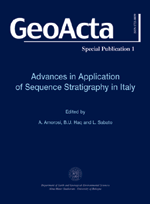|
|
Carmelo Saccà, Domenica Saccà, Preziosa Nucera, Daniele D'Urso
Dipartimento di Scienze della Terra, Università di Messina, Salita Sperone 31, 98166 S. Agata di Messina (ME), Italy, e-mail: carmelo@labcart.unime.it
|
Sergio Galli
Dipartimento di Fisica, Università di Messina, Salita Sperone 31, 98166 S. Agata di Messina (ME), Italy, R.o. box 55, e-mail: sergio@tiscali.it
|
|
|
|
Chemical, mineralogical and grain size features of Pliocene sediments near Maida (Catanzaro, Southern Italy)
|
|
|
|
|
|
|
|
PDF
(368 KB)
|
Abstract
Sediments from deposits cropping out in central Calabria, near Maida and Vena (Catanzaro), were examined. Additional samples from the surrounding areas, and only from similar outcrops, were collected, with the aim of carrying out a compositional comparison.
This study forms part of an in progress research program, the aim of which is the characterization, for application purposes, of clay sediments from outcrops in north-eastern Sicily and Calabria. Chemical, mineralogical, grain size and micropaleontological analyses were carried out.
The examined sediments are referred to the early Pliocene (MPL2-MPL3, Pliocene biozonation according to Cita, 1975).
Based on grain size analyses, samples from the main section can be classified as silts and clayey silts. Microscopic examination shows that the biogenic component is predominant in the > 63 µm size fraction, and is essentially made up of Foraminifera in an optimal state of preservation.
Chemical and X-ray diffraction (XRD) analyses were carried out on size fractions smaller than 4 µm. The study carried out on decarbonated samples shows that the main components are represented, in order of abundance, by quartz, carbonates and clay minerals. Clays are mainly made up of kaolinite, smectite, and precisely montmorillonite, vermiculite, scarce illite and ferrous-type chlorite.
In addition, spectroscopy FTIR studies showed the presence of muscovite and calcite, aragonite and dolomite, as carbonates.
Keywords: Pliocene, Clays, Calabria, Mineralogy, Geochemistry, Micropaleontology
|
|


